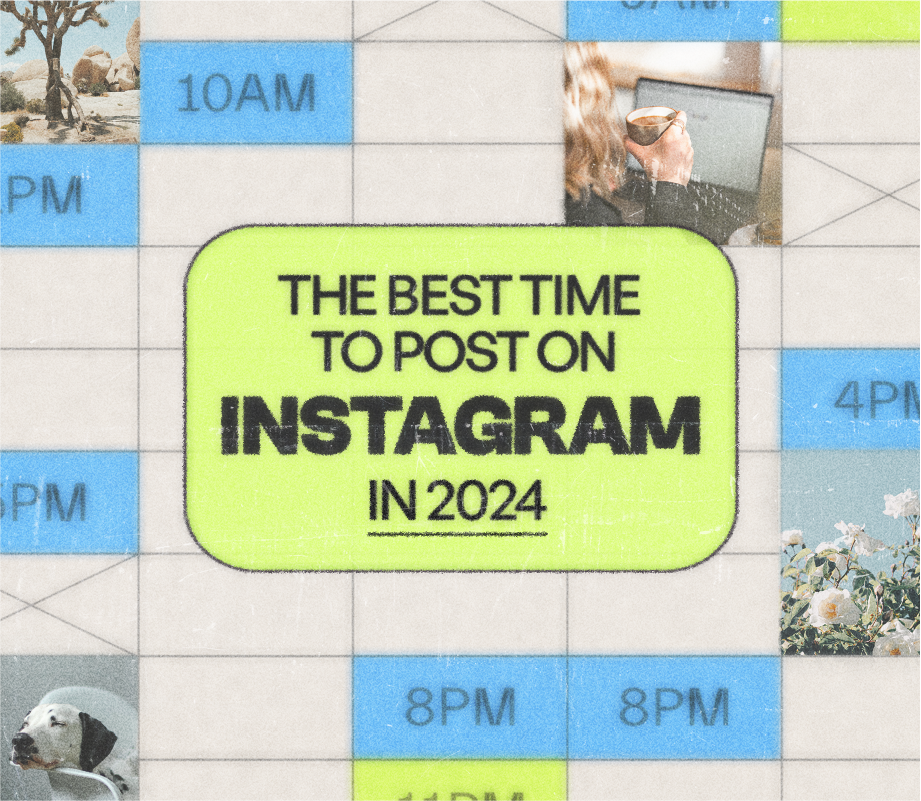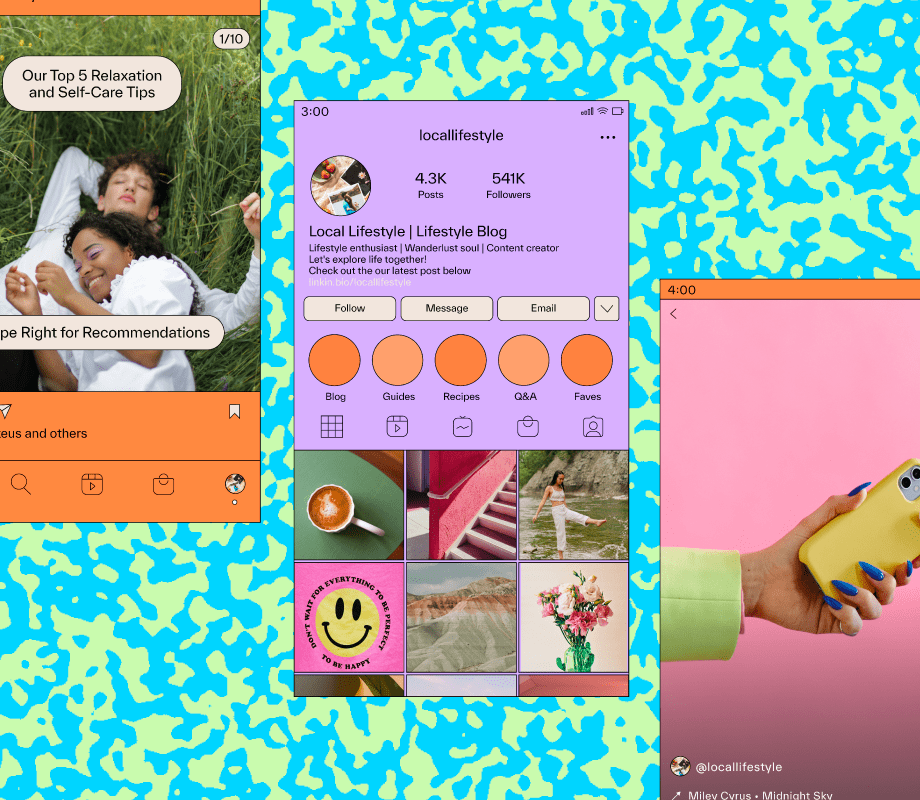With over 2 million monthly advertisers, more businesses are realizing how effective Instagram advertising can be!
Whether you’re looking to grow your Instagram account, make sales, or drive more traffic to your website, a creative and well-targeted Instagram ad campaign can drive great results.
In our Ultimate Guide to Instagram Advertising, we cover everything you need to create, launch, and measure the success of your first Instagram ad campaign!
We also created a free infographic of the different Instagram ad types for easy reference! Check it out below:
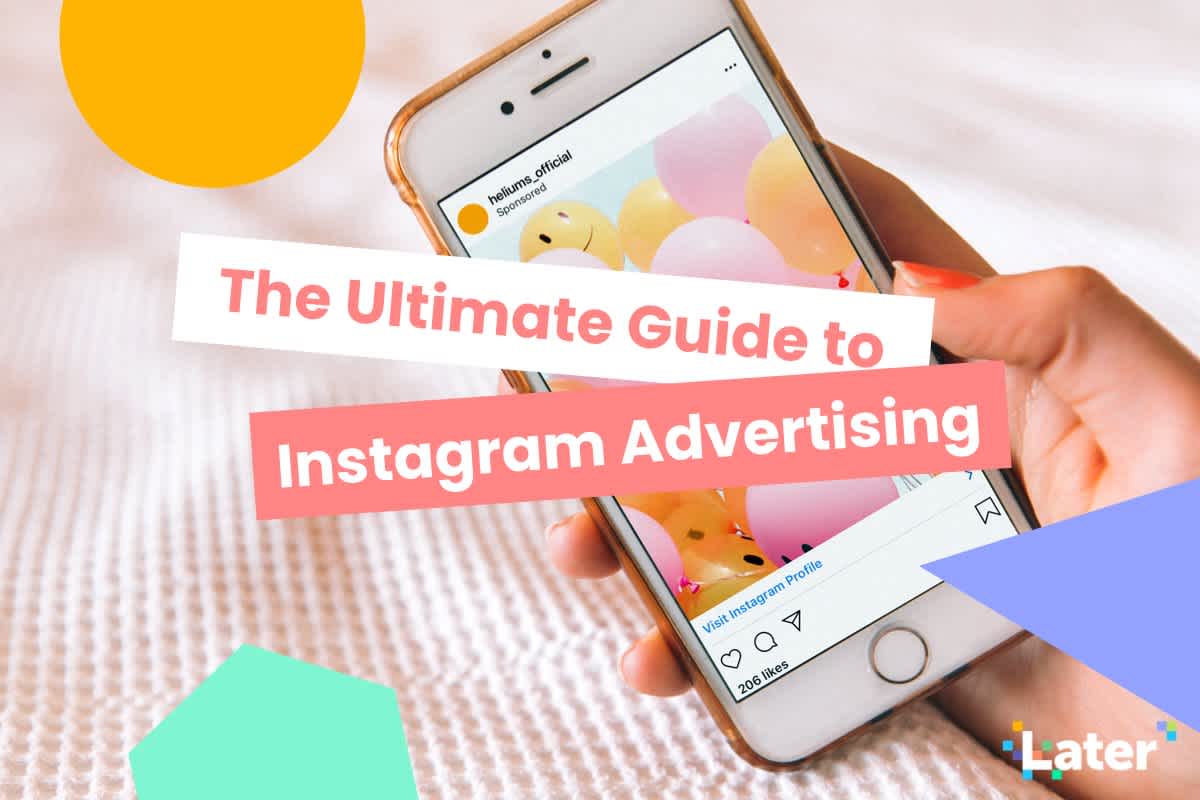
Table of Contents:
How to Find the Right Campaign Objectives for Your Instagram Ads
How to Select the Right Targeting Options for Your Instagram Ads
How to Pick the Perfect Instagram Ad Format for Your Campaign
Why You Should Advertise on Instagram
The number of monthly active users (MAUs) on Instagram has skyrocketed in recent years, and there’s a good chance your target customers are on there too!
Younger audiences in the 18-29 range are particularly well-established on Instagram. And given their willingness to shop online, tapping into this demographic via high-quality, targeted ads could result in a huge number of sales for your business.
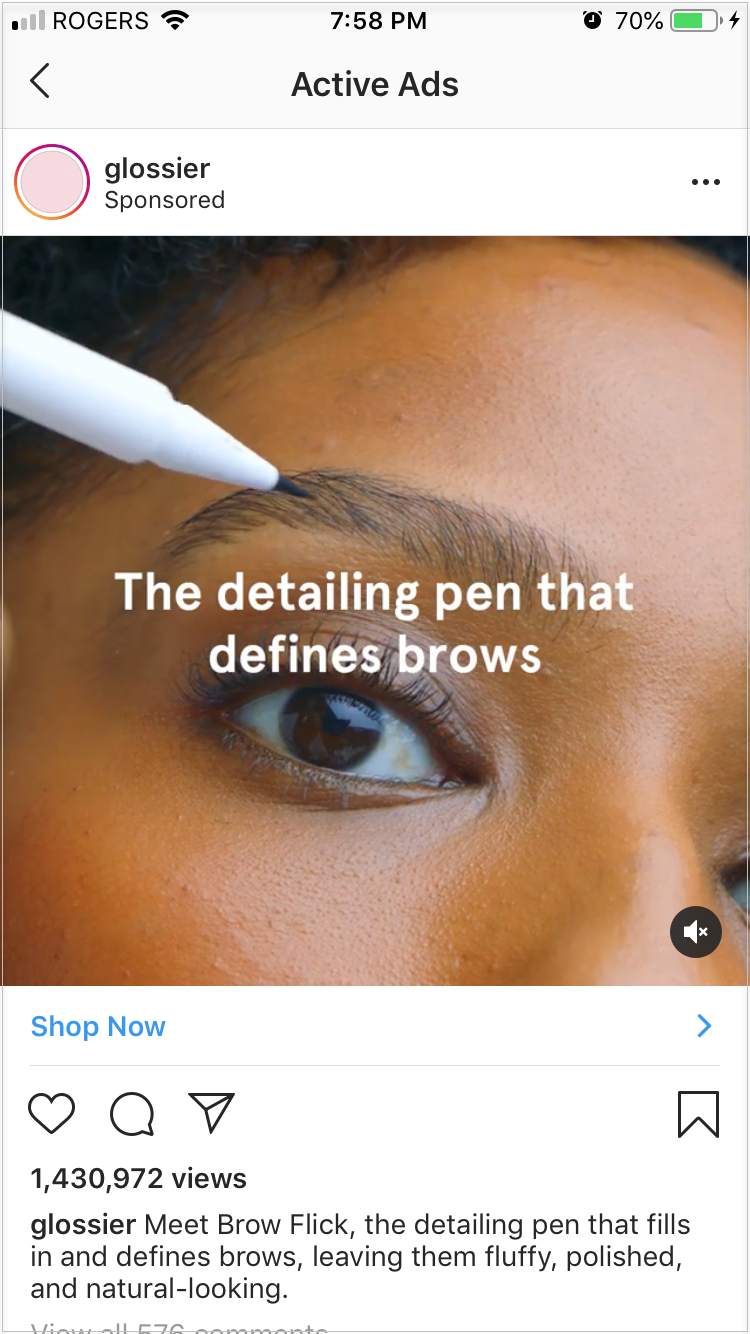
Of course, that’s not to say that Instagram advertising is only effective for ecommerce! Businesses in all kinds of verticals can benefit from creating and sharing high-quality Instagram ads — everything from software brands to non-profits.
Here are a few more reasons why your business should advertise on Instagram:
#1. Anyone can advertise on Instagram
Thanks to Instagram’s “promoted posts” ad format, which is extremely easy to set up, there’s a very low barrier to entry for running ad campaigns on Instagram.
#2. You get access to Facebook’s advanced targeting tools
Instagram uses Facebook’s advertising platform, which is widely considered one of the best in the world.
Facebook provides tons of targeting options — you can reach people based on their behavior on your website, their engagement with your Facebook page, and other demographic data like age, gender, and location.
#3. Audience engagement on Instagram is still really high
Instagram users are more engaged than the average social media user. And while trends do seem to show that Instagram engagement is dropping, the platform is still producing higher engagement rates for businesses compared to both Twitter and Facebook.
#4. Instagram ads look and feel like organic content
Because Instagram ads are relatively subtle, users are much less likely to succumb to “banner blindness” when scrolling their feeds.

#5. Instagram is already a big “shopping” destination
Instagram has already played heavily into shopping (tons of features that promote organic shopping experiences), so audiences are already primed to be sold to.
Now that we’ve looked at why your business should advertise on Instagram, let’s look at the different Instagram ad objectives and how to pick the right one for your campaign:
How to Find the Right Campaign Objectives for Your Instagram Ads
When advertising on Instagram, you can choose from several campaign objectives (i.e. the “action” you want people to take when they see your ads) — and picking the right one is really important as it will influence how your Instagram ads are optimized and how you pay for them.
For example, if your goal is to drive traffic to a specific URL, you probably don’t care as much about how many likes and comments your ad receives.
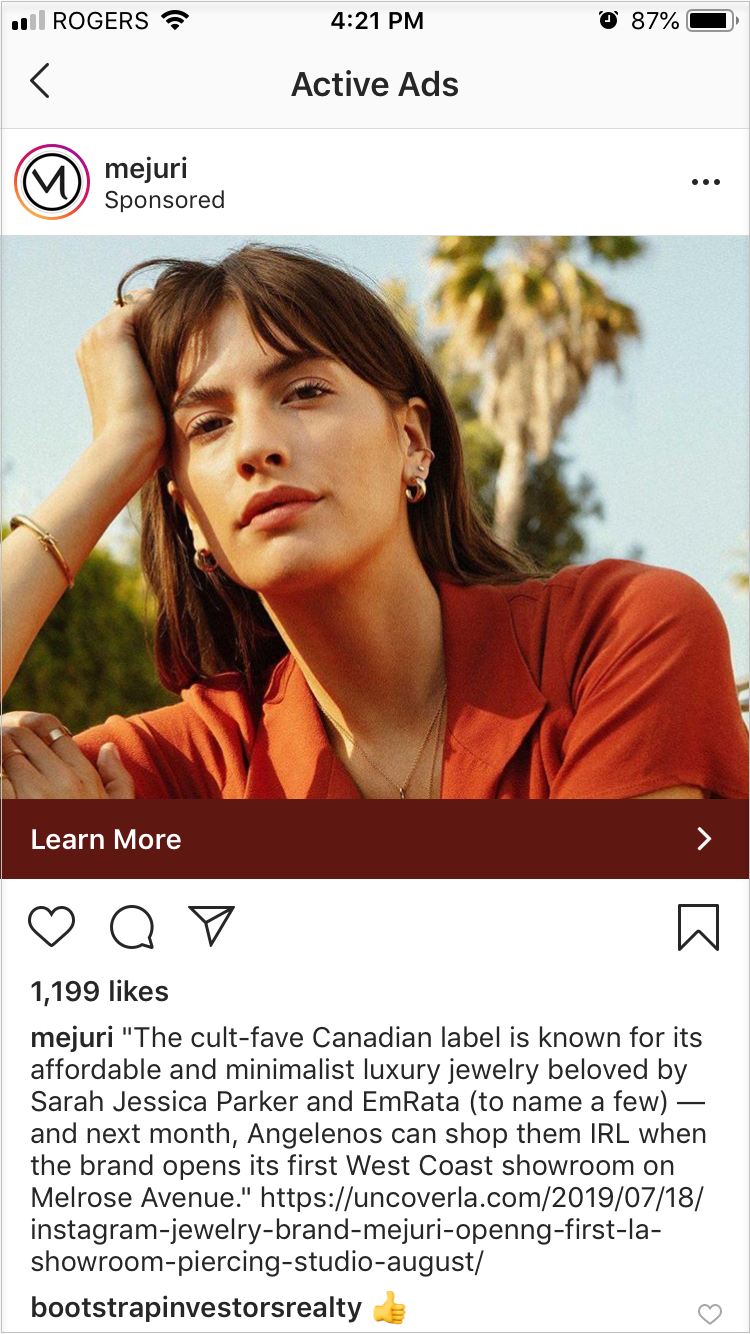
On Instagram, you can pick from the following campaign objectives:
1. Brand awareness: reach people more likely to pay attention to your ads and increase awareness for your brand
2. Reach: show your ad to the maximum number of people
3. Traffic: for clicks to your website or to the app store for your app
4. Engagement: get more people to see and engage with your post or Page. Engagement can include comments, shares, likes, event responses and offer claims
5. App installs: send people to the store where they can download your business’ app
6. Video views: promote videos that show behind-the-scenes footage, product launches or customer stories to raise awareness about your brand
**7. Lead generation:** create ads that collect info from people interested in your product, such as sign-ups for newsletters
8. Messages: connect with people on Facebook, communicate with potential or existing customers to encourage interest in your business
9. Conversions: get people to take valuable actions on your website or app, such as adding payment info or making a purchase
10. Catalog sales: show products from your ecommerce store’s catalog to generate sales
11. Stores traffic: promote your brick-and-mortar business locations to people that are nearby
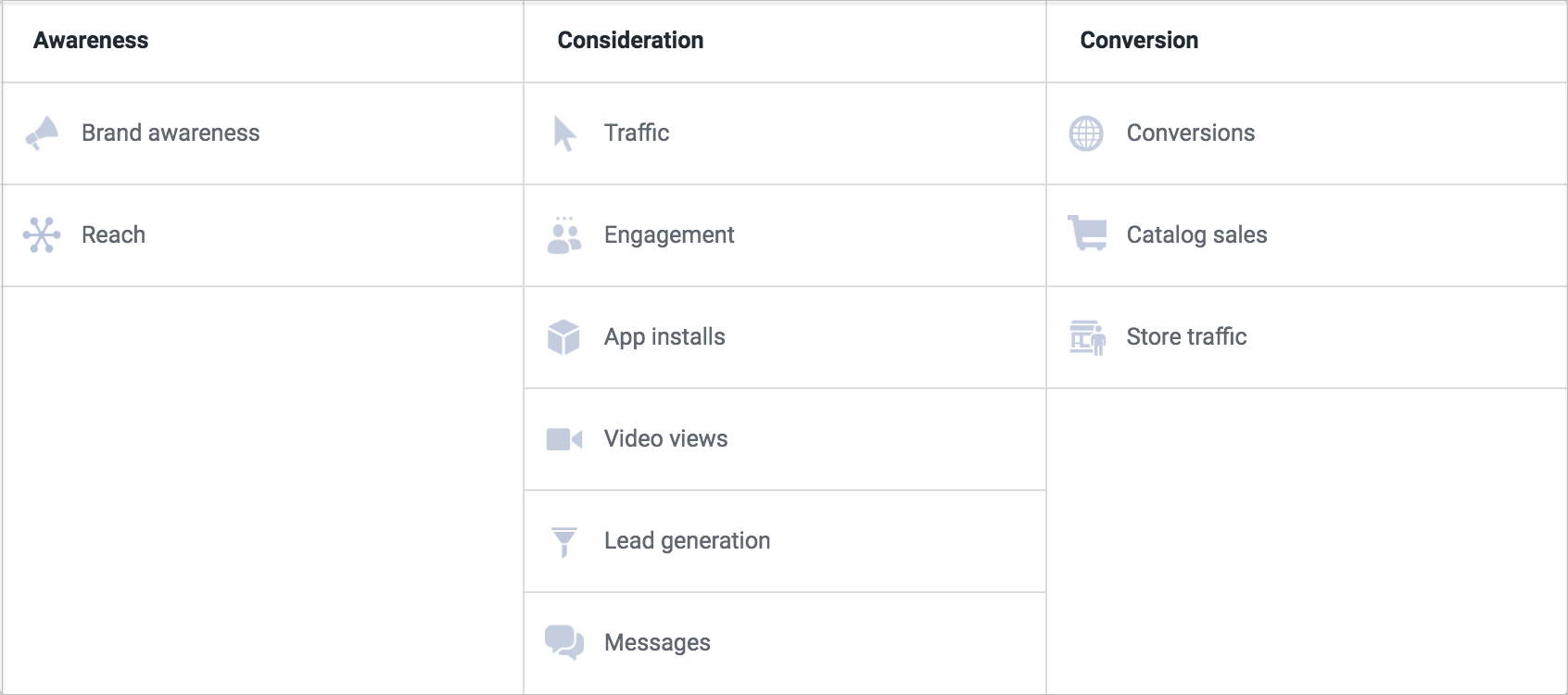
It’s important to know what you want to achieve in order to choose the right objective for your ad.
For example, if you’re trying to drive sales for a new product launch, you can create ads that encourage people to visit your store and make a purchase.
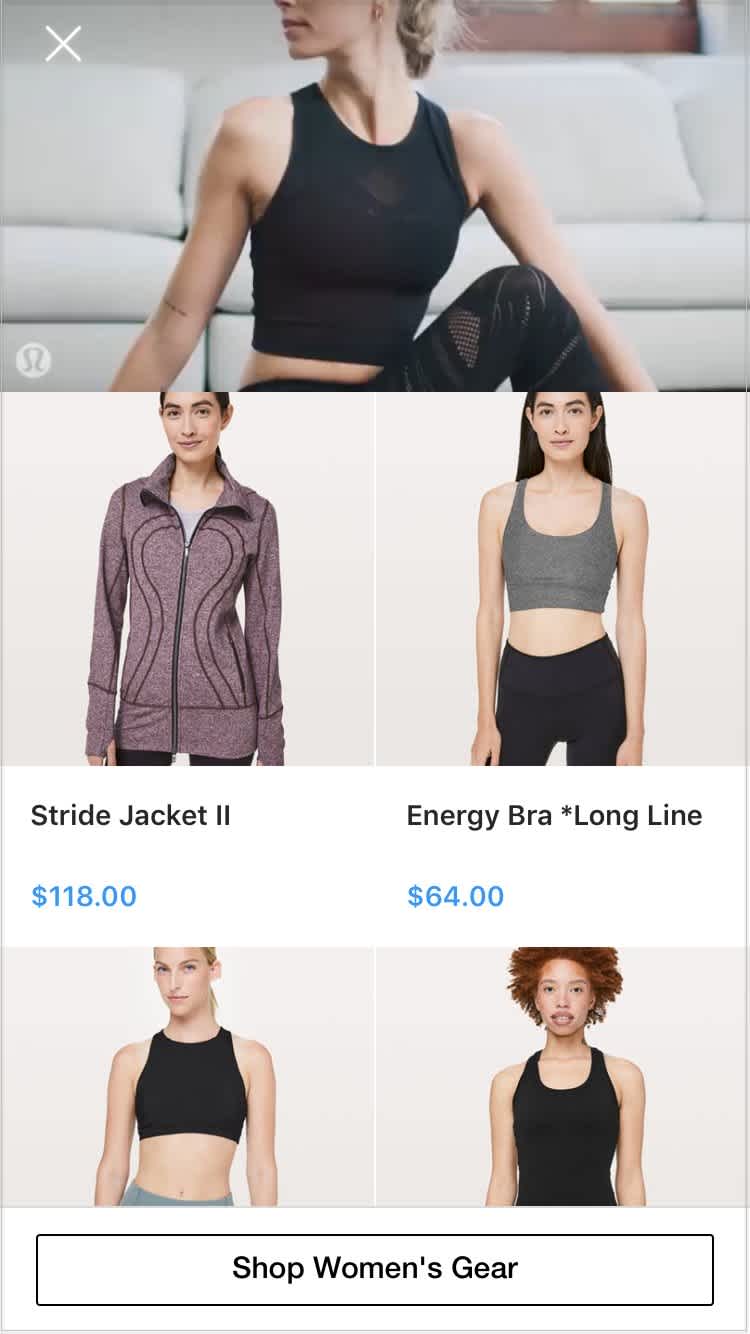
On the other hand, if your goal is to promote a new article, you can use the Traffic objective to create a campaign that encourages people to visit your blog or site.
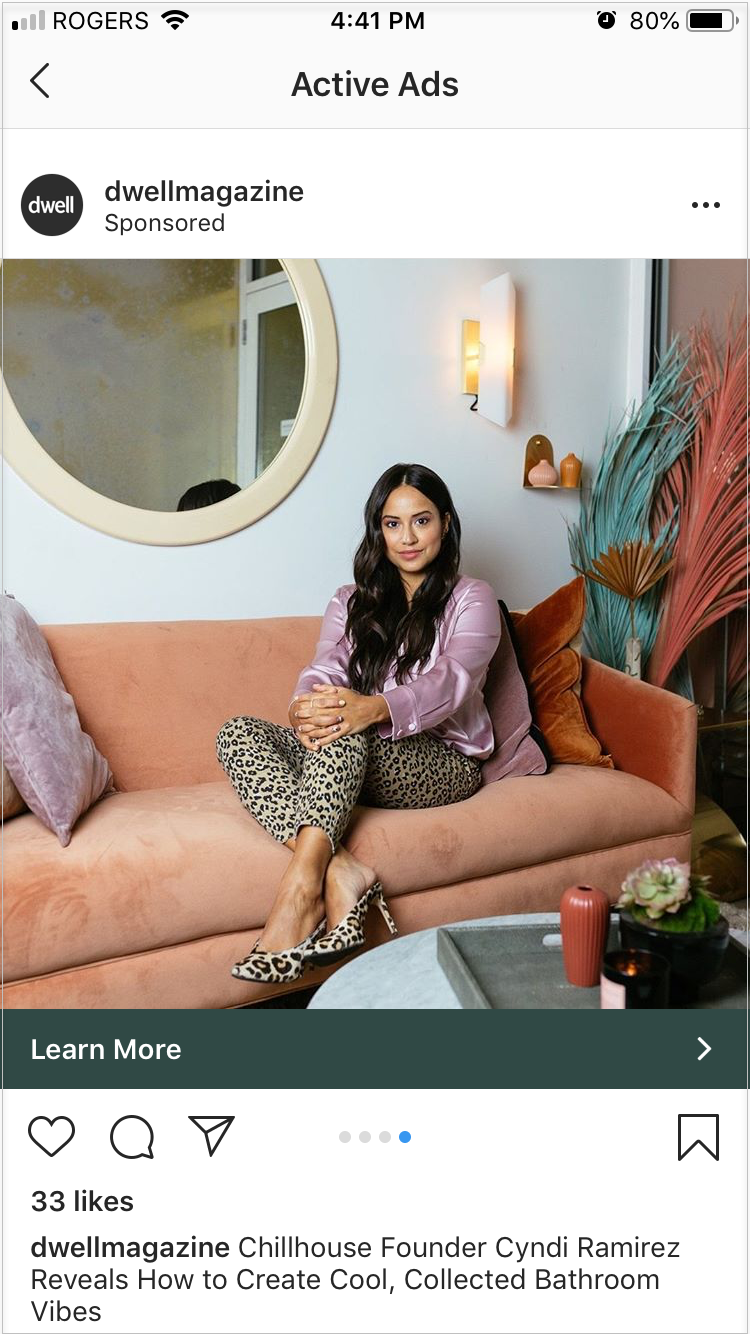
Here are three broader categories, or goals, that your objectives may fall under:
#1: Awareness Campaign Objectives
“Awareness” campaign objectives are ones that aim to generate interest in your product or service.
For example, if you’re in the process of launching a new hotel, using the Brand Awareness objective, you could create a campaign that highlights your brand (and maybe a promo code!) to people in the local area.

Best campaign objectives for boosting awareness:
Brand awareness
Reach
#2: Consideration Campaign Objectives
“Consideration” campaign objectives are ones that get people to think about your business and seek more information.
For example, if you have a website that tells your story and lists some of your store’s unique offerings, using the Traffic objective, you can create a campaign that encourages people to visit your site to learn more.
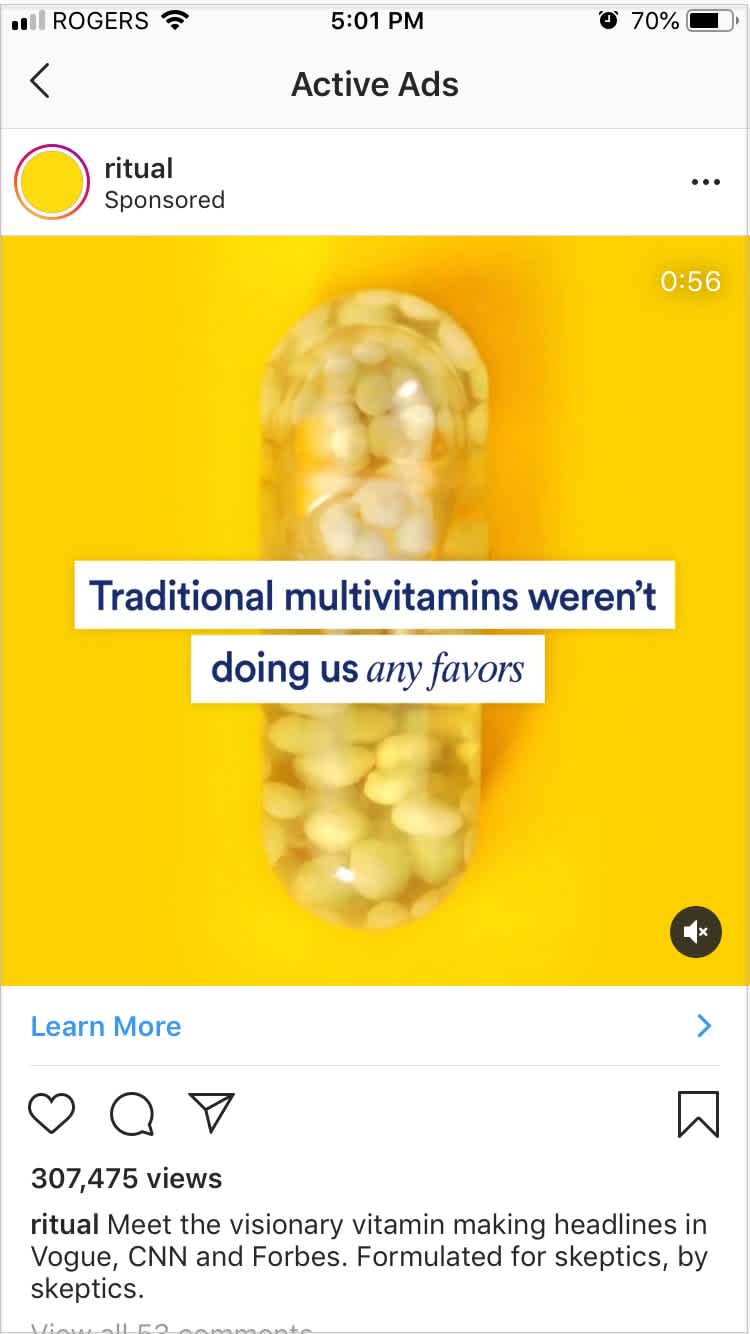
Best campaign objectives for building consideration:
Traffic
Engagement
App Installs
Video Views
Lead Generation
Messages
#3: Conversion Campaign Objectives
“Conversion” campaign objectives are ones that encourage people who are interested in your business to buy or use your product or service.
For example, if you’re an ecommerce brand that launched a new product line, using the Store Visits objective, you can create a campaign to encourages potential customers to buy your new products.

Best campaign objectives for driving conversions:
Conversions
Catalog Sales
Store Traffic
Something to note about conversion-based objectives is that if your goal is to sell ecommerce products or to run a remarketing campaign for users who visit your website, you have to create and install a Facebook pixel first.
Never heard of a Facebook pixel? Basically, it’s a small piece of code that you can place on your website to track visitors and conversions.
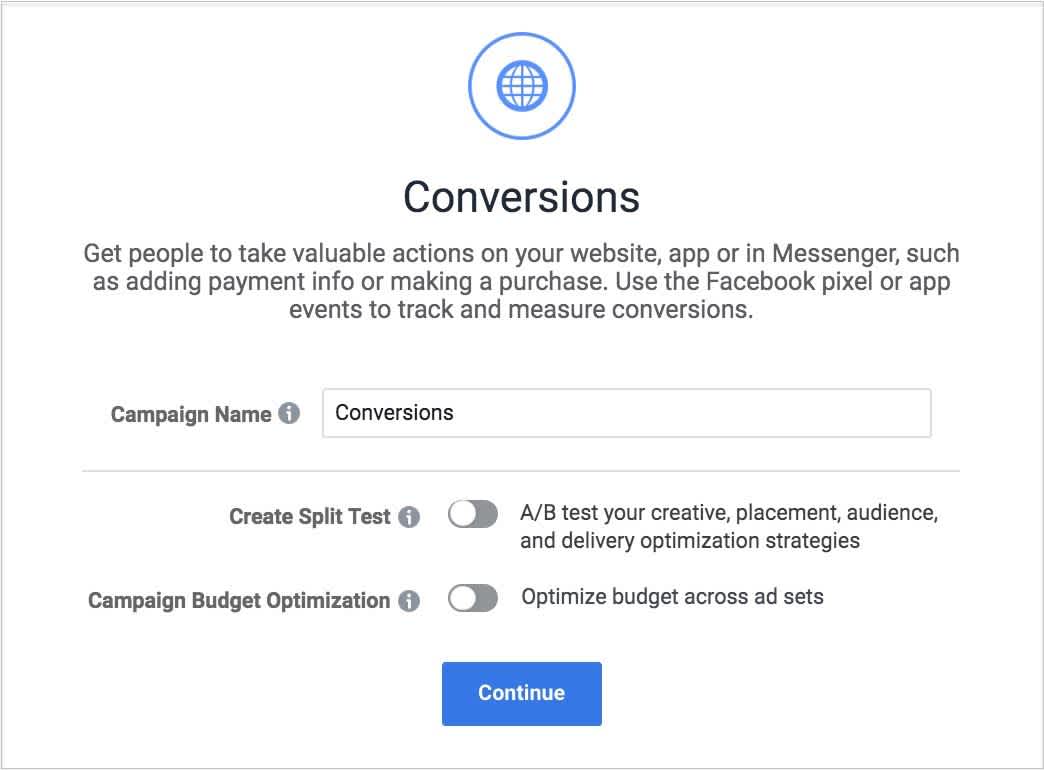
If you have a Facebook pixel on your website, when someone clicks on your Instagram ads, visits your website, and purchases one of your products, the pixel tells Facebook that a conversion occurred.
Facebook then matches that conversion against the set of people who clicked on your Instagram ads so that you can see how many sales you actually made from that ad.
If you need some help setting it up, you can follow this guide on how to create and install a pixel within Facebook’s Ads Manager.
How to Select the Right Targeting Options for Your Instagram Advertising
Instagram ads targeting is about trying to find the best person to advertise to — as in, who is the most likely to perform the action you specified in your campaign objective.
For example, if you’re a Los Angeles-based aromatherapy brand, you’re going to try and target people who are most likely to purchase your products: people who live in LA who match your target audience and have expressed an interest in aromatherapy.

Luckily, Instagram ads have all the same targeting options as Facebook ads, including targeting based on location, demographics, interests, behavior, and more.
At the most basic level, your campaign needs to target a specific country, gender (if promoting a gender-specific offer) and age group. For example, your campaign could target women and men aged 18 to 40 who live in big fashion-forward cities.
But it’s better to get as narrow as possible with your target marketing! The more targeted your ads are to the right audience, the better chance they have of achieving your campaign objective.
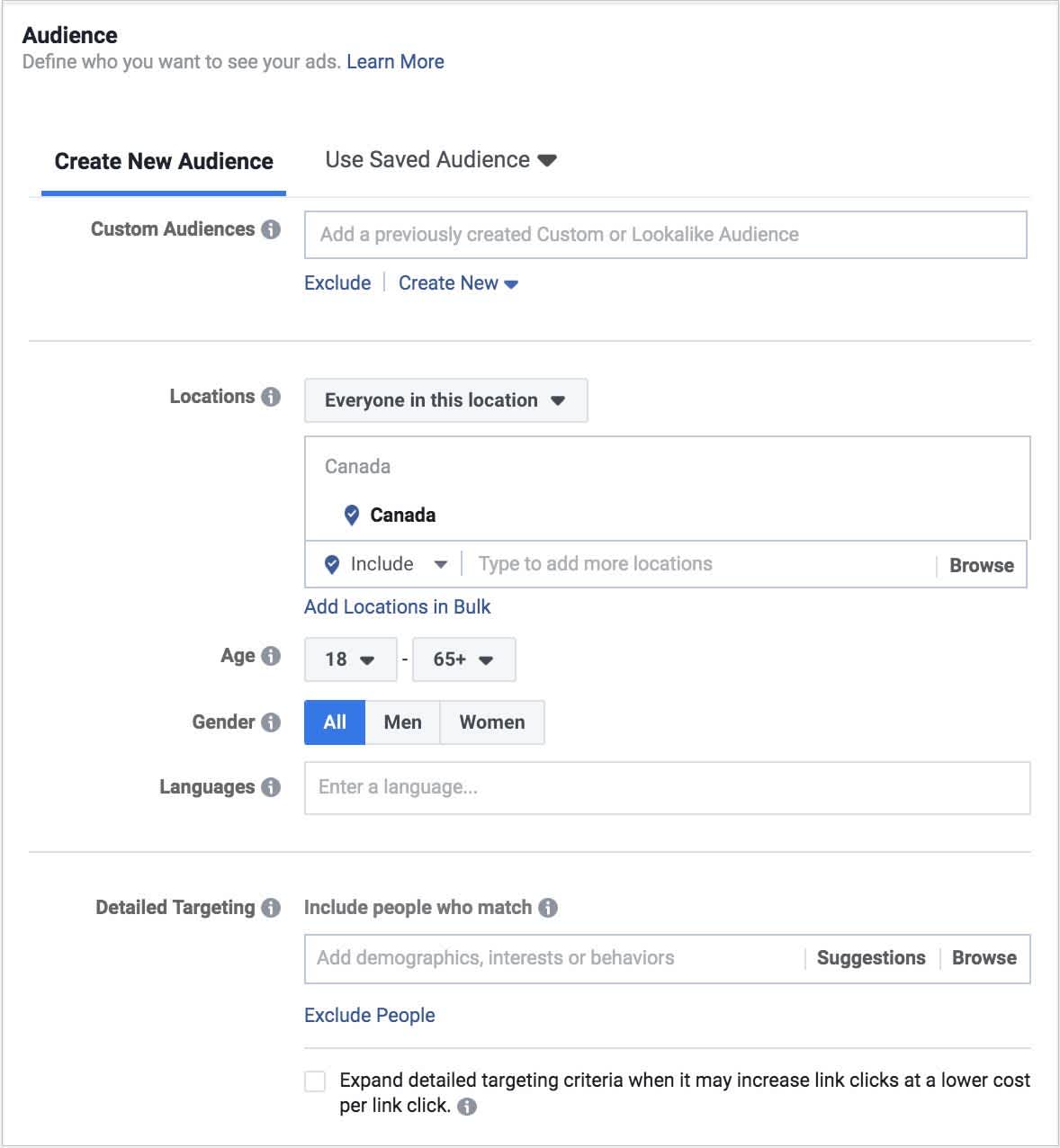
You also have the option to create a Custom Audience to reach people who have already interacted with your business, or a Lookalike Audience to reach new people on Facebook who are similar to your most valuable audiences.
Custom Audiences
Facebook Custom Audiences are groups of people who have already visited your website or shared their contact info with you.
Ads targeting these groups tend to perform really well because they’ve already expressed an interest in your business!
When you set up targeting on Facebook based on location, demographics, interests, behaviors, or any of the other options Facebook provides, you are building a regular audience. As you select targeting options, you’ll notice your potential reach grow or shrink under the Audience Definition section to the right of your targeting options.
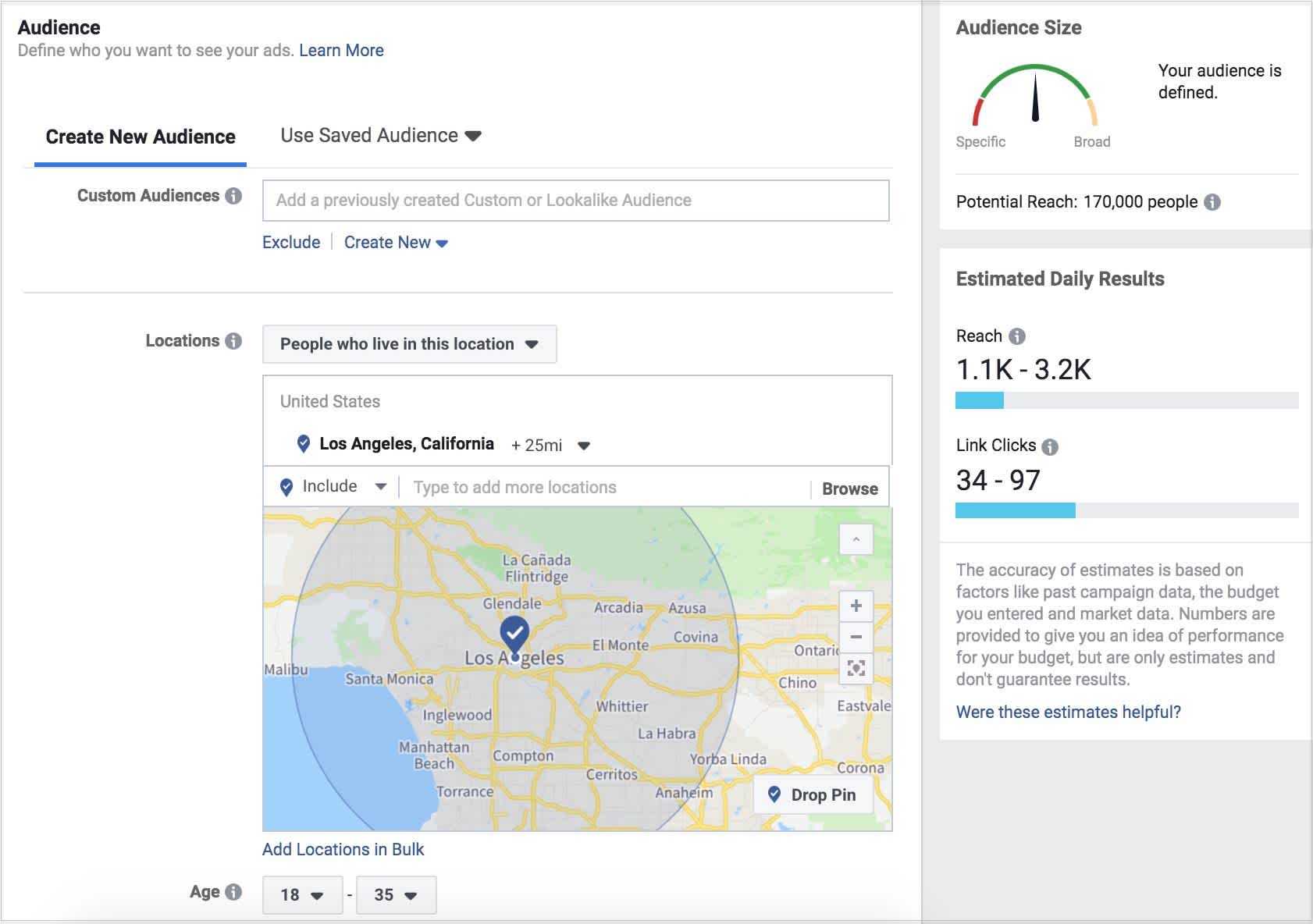
When you build a custom audience, you don’t select any of Facebook’s built-in targeting options.
Instead, you upload a database of emails or phone numbers and Facebook matches those up with Facebook users. You can then target ads to this audience on Instagram.
For example, using our ecommerce business example from above, if you collect information about your audience (email, phone number, first and last name, city, state/province, country, etc.) through a newsletter, surveys, interviews, or otherwise, you can upload this data to Facebook’s Ads Manager.
Simply navigate to the Ads Manager, open Tools, click the Create New dropdown and select Custom Audience.
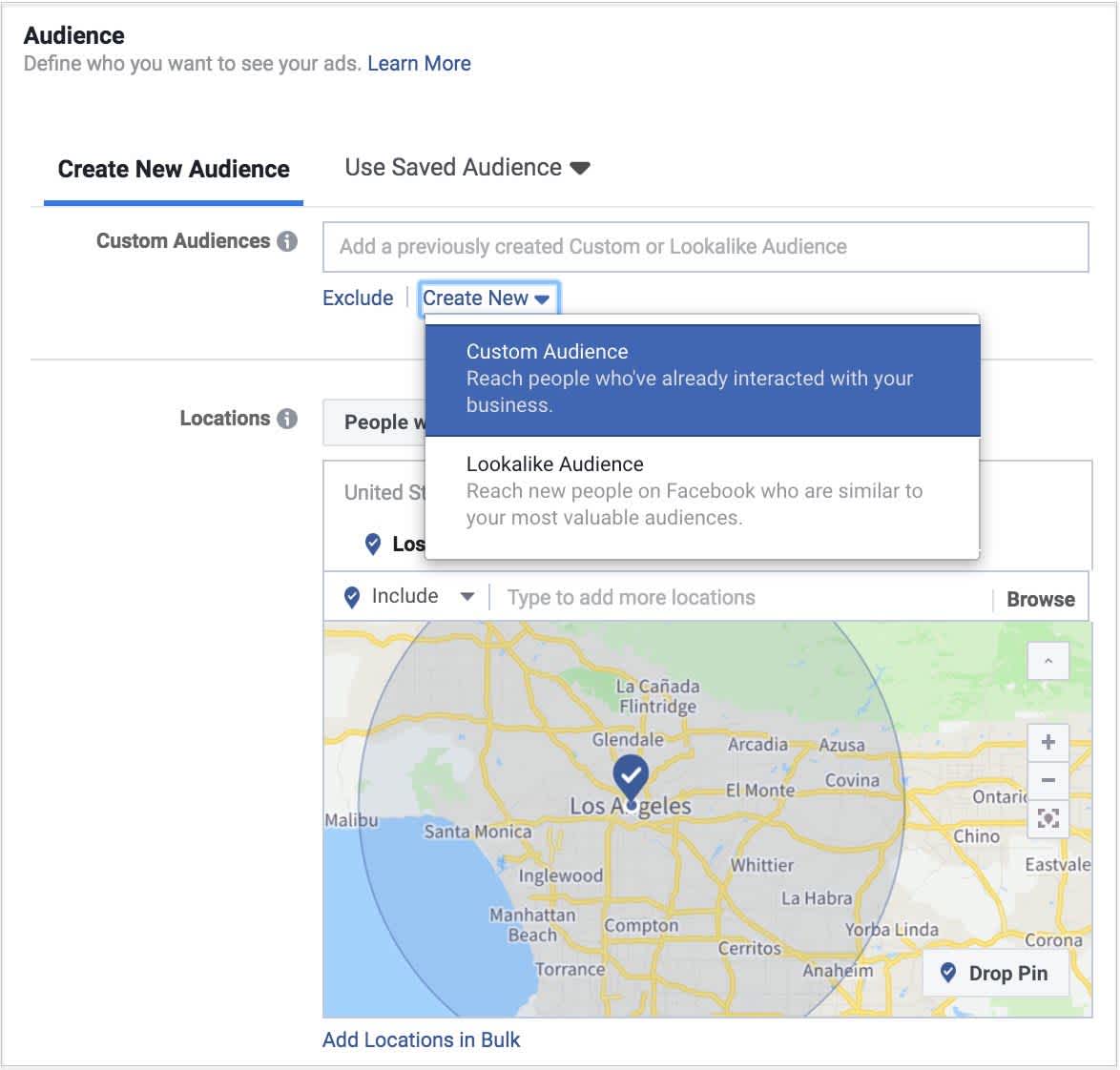
Next, select Add customers from your own file.
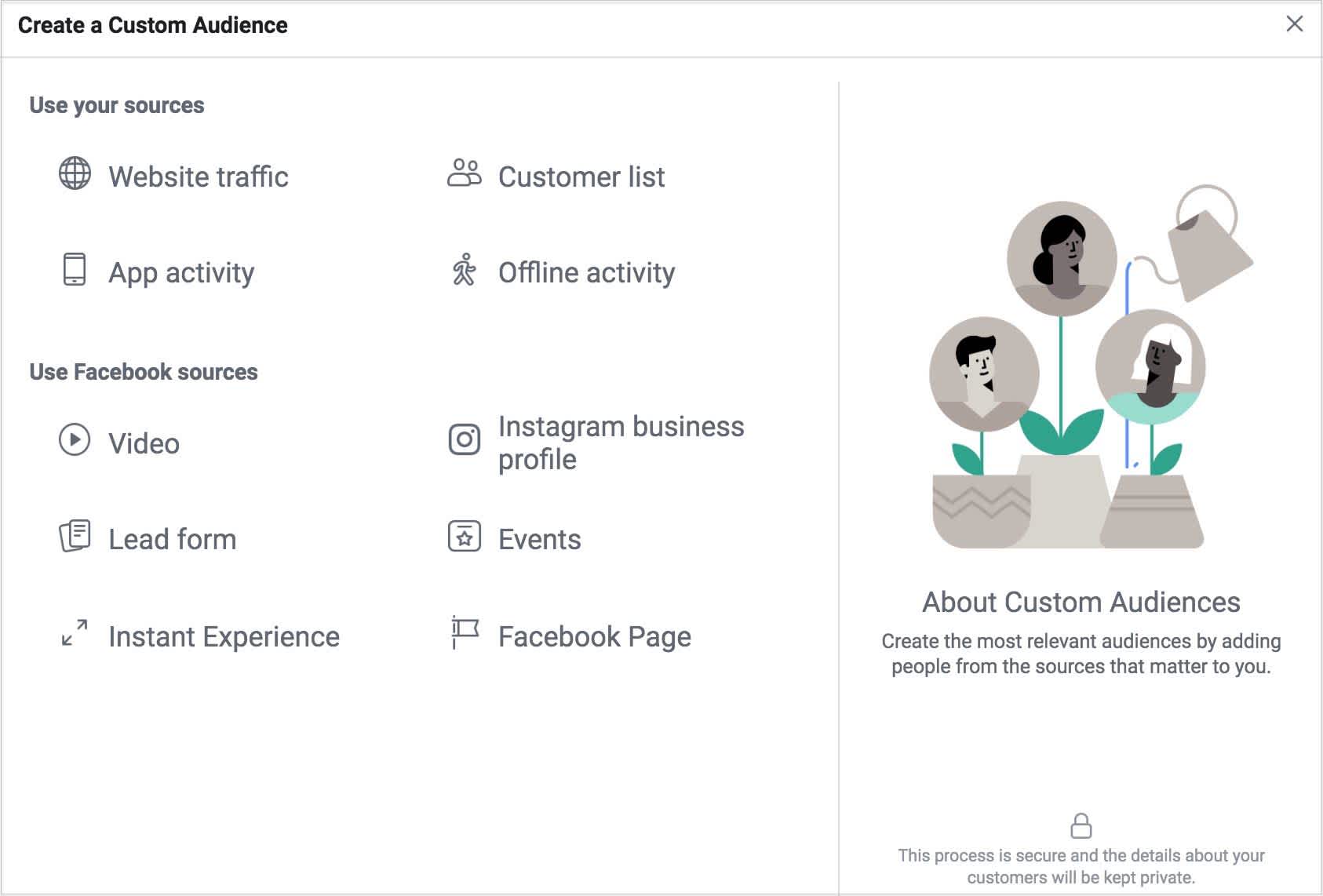
After uploading your data, Facebook will create a new custom audience that you can target with your Instagram ads.

Lookalike Audiences
A Facebook Lookalike Audience is a type of custom audience that allows you to create super-specific targeting for your ads.
These audiences tend to convert really well because they target people who are most like your established customers!
Basically, Lookalike Audiences let you take your custom audience and then serve ads to people who are similar to that audience.
Facebook identifies the common qualities of the people in your audience, such as demographics or interests, and then finds people who are similar to them in the country you choose.
You can also create a lookalike audience based on people who like your current Facebook Page. This could lead to better results because you’re targeting people who already know your business and have shown an interest in what you have to offer.

You can narrow your reach even further by collecting targeted information about your audience’s demographics, interests, and behaviors. Facebook’s Audience Insights and Google Analytics are two of the best tools to do this:
#1. Facebook Audience Insights
Audience Insights is a tool from Facebook that lets you gather insights about your target audiences, including aggregate information about geography, demographics, purchase behavior, and more.
You can use Audience Insights to help make advertising decisions about who you should be targeting.
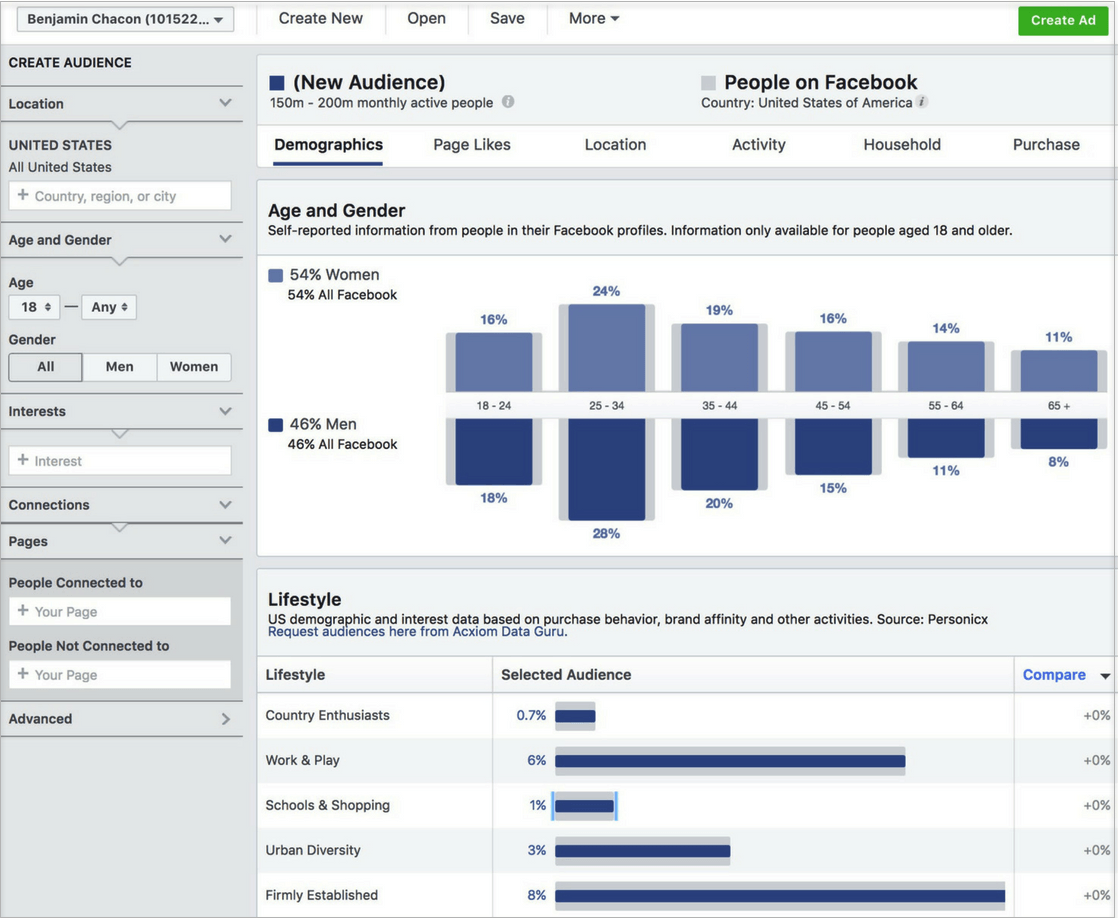
#2. Google Analytics
If you use Google Analytics to track traffic to your website, you can use also use it to collect demographic information about your target audience.
Under the Admin section, go to Property Settings for your desired analytics property. Next, go to Data Collection under Tracking Info. Then, toggle the switch under Advertising Reporting Features on.
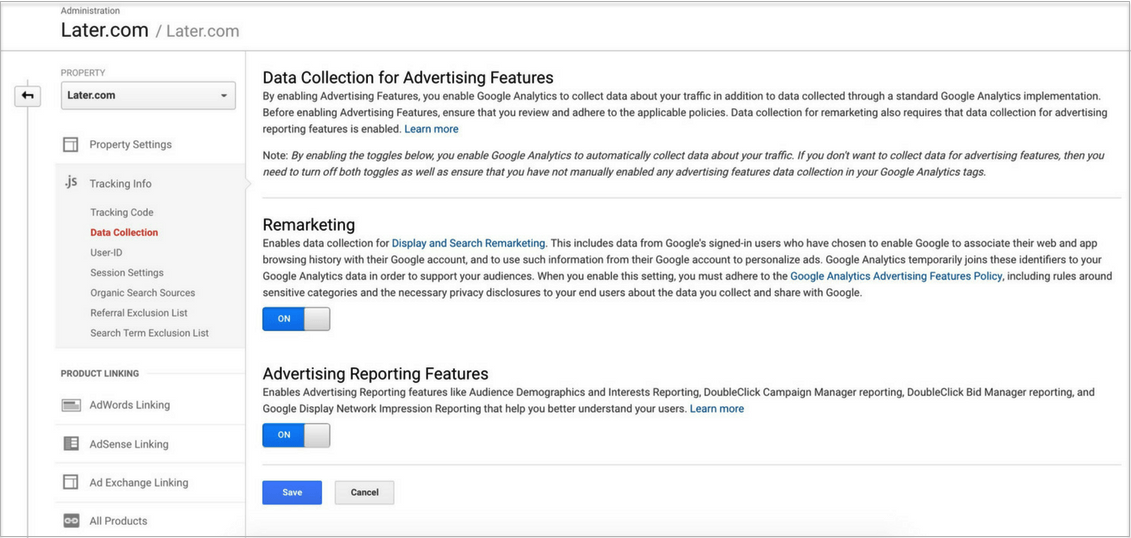
How to Pick the Best Instagram Ad Format for Your Campaign
Instagram offers a number of different ad formats — which be can be daunting if you’re planning your first campaign!
In the following section, we breakdown each format, explaining how they work, what they’re best for, and share tips on how to optimize the size and specs of your Instagram ads.
We also created a free infographic for easy reference! Check it out below:

#1: Instagram Photo Ads
The original! Instagram photo ads are great if you’re looking to showcase your products and services through a clean and simple canvas.
If you’re already creating custom visual content, you should definitely consider testing photo ads on Instagram.
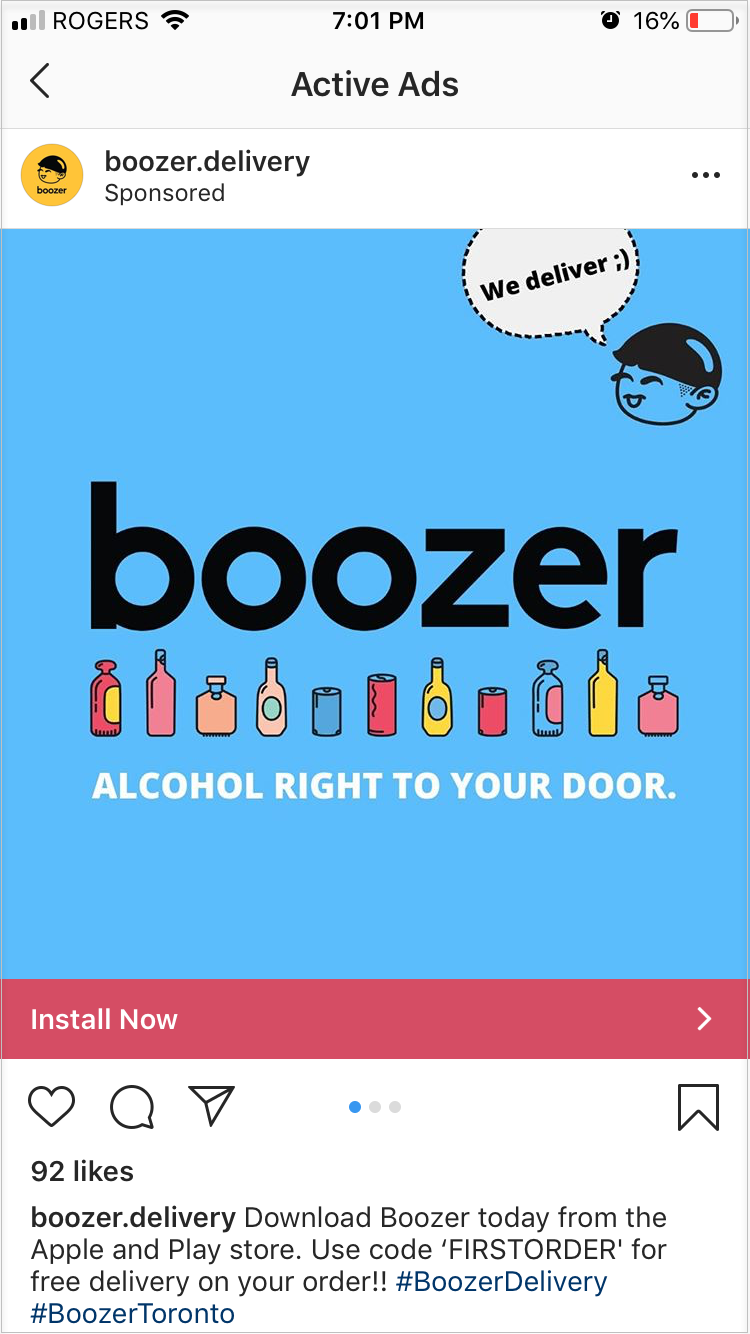
File type: JPG or PNG
Size: a maximum of 30MB
Orientation: square, portrait, and landscape
Resolution: Instagram recommends uploading the highest resolution available that meets aspect ratio requirements
Aspect ratio: a minimum of 1.91:1 and a maximum of 4:5
Caption text: a maximum of 2,200 characters but 125 is recommended (two rows of text will appear)
Objectives supported: all except Video Traffic
#2: Instagram Video Ads
A recent study on Instagram engagement discovered that video posts receive twice the engagement of other post types — and this definitely carries over to Instagram ads.
But beyond the high engagement numbers, there are tons of other reasons to invest in video. The main one: Instagram video ads give you the ability to share complex, in-depth stories that can’t be conveyed in a single image.

File type: Most file types are supported however, Instagram recommends MP4 and MOV.
Size: a maximum of 4GB
Video length: 1 to 120 seconds
Orientation: square, portrait, and landscape
Resolution: Instagram recommends uploading the highest resolution available that meets aspect ratio requirements
Aspect ratio: a minimum of 1.91:1 and a maximum of 4:5
Caption text: a maximum of 2,200 characters but 125 is recommended (two rows of text will appear)
Objectives supported: all
Instagram video ads are particularly helpful for telling your brand’s story or showcase how a product or service works.
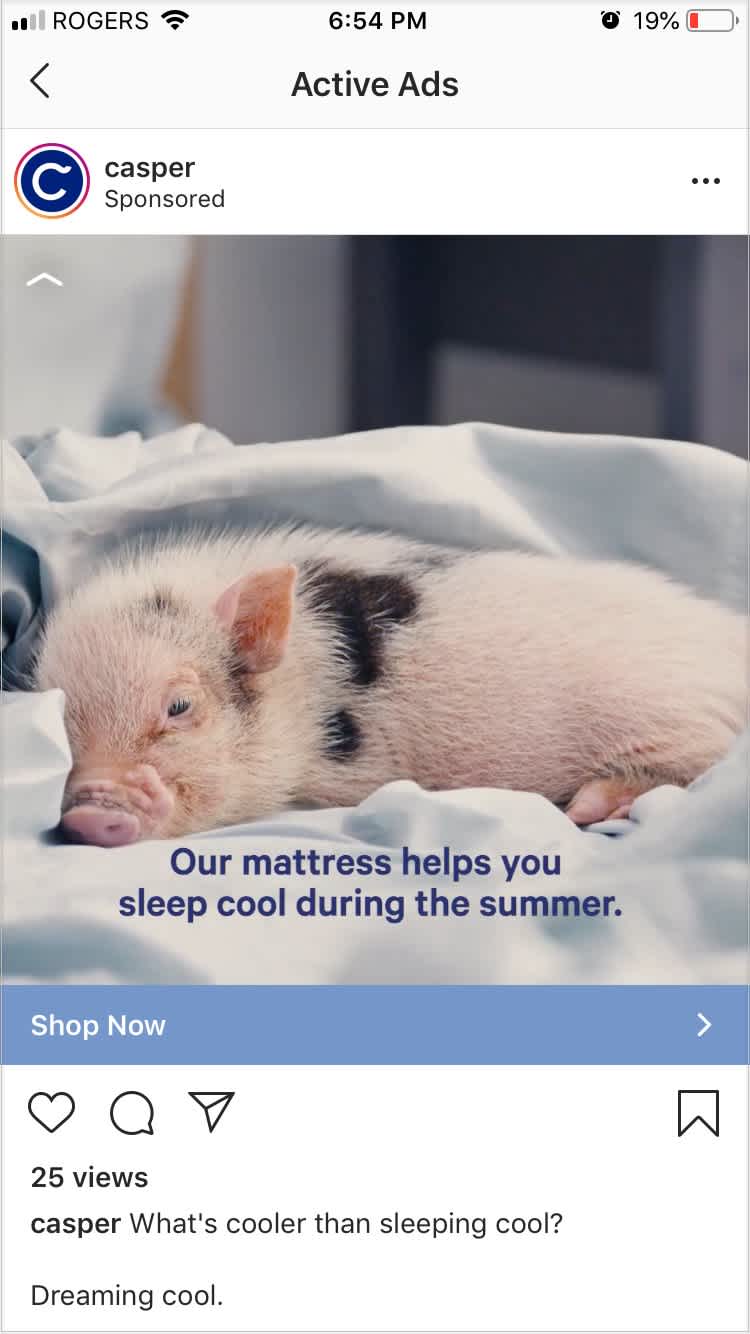
When designing new video ads, try creating content that blends organically into your followers’ feeds.
It’s also a good idea to stick to a single theme or focus. The last thing you want to do is overwhelm your audience with a ton of information!
#3: Instagram Stories Ads
Instagram Stories ads are the perfect way to reach new audiences and showcase your brand, business, and products to an already engaged audience.
According to Instagram, 500 million Instagram accounts use Instagram Stories every day. And businesses are seeing a ton of success with stories ads for a range of objectives!
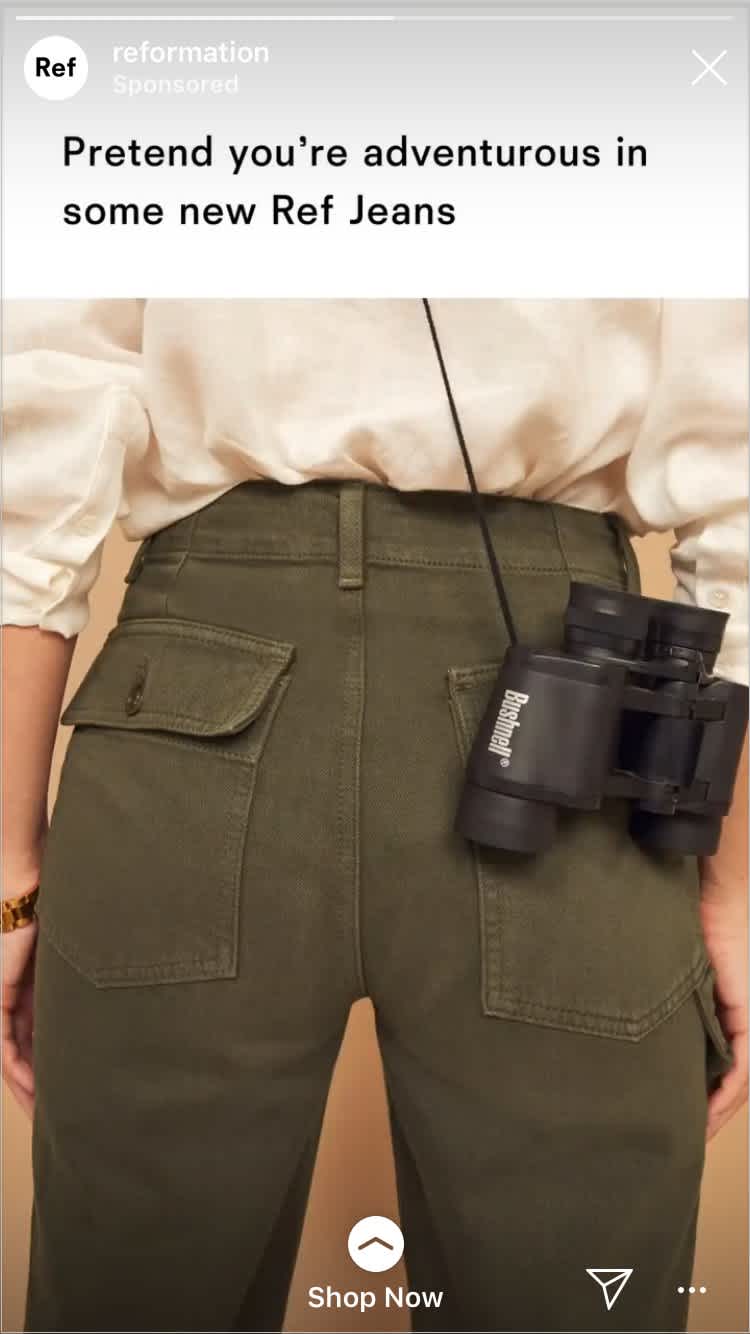
File type: JPG or PNG for photos, MP4 or MOV for videos
Size: a maximum of 30MB for photos and 4GB for videos
L**ength:** a maximum of 5 seconds for photos and 120 seconds for videos
Orientation: square, portrait, and landscape
Resolution: Instagram recommends a resolution of 1080px by 1920px
Aspect ratio: a minimum of 1.91:1 and a maximum of 9:16
Objectives supported (photo): all except engagement, video views, messages, catalog sales, and store traffic
Objectives supported (video): all except messages, catalog sales, and store traffic
If you want to create an Instagram Stories ad that converts, it’s important to have a short and punchy message that is easy to read.
You should also consider making your stories ads less “polished” than your other Instagram advertising content.
That’s because people are used to watching casual Instagram Stories content from their friends. If they see a highly produced video pop up in their stories, it can come across like a commercial, and they will naturally swipe away.
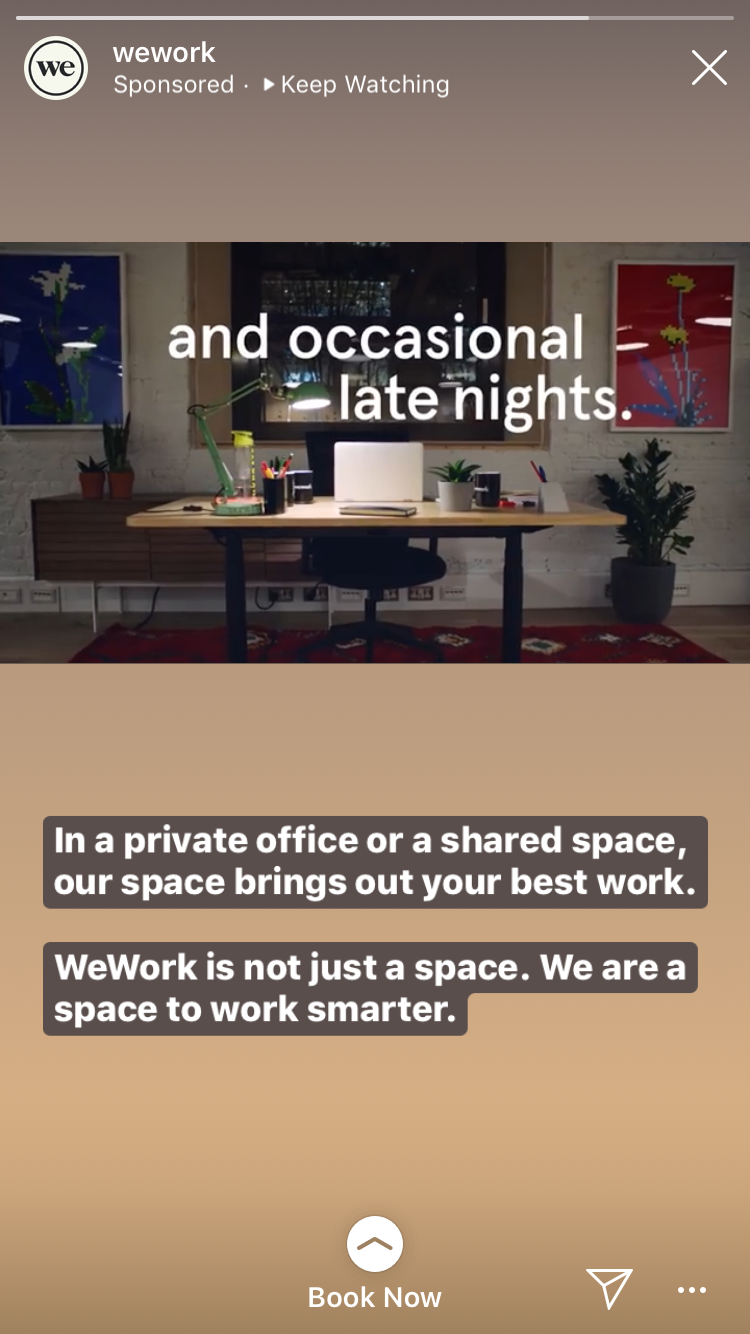
Check out our top 9 tips for creating Instagram Stories ads that convert!
#4: Instagram Carousel Ads
When it makes strategic sense to showcase multiple products (or multiple uses of a single product), carousel ads are a great option.
With carousel ads, Instagram users can swipe to see additional photos or videos, and tap on a call-to-action to learn more.
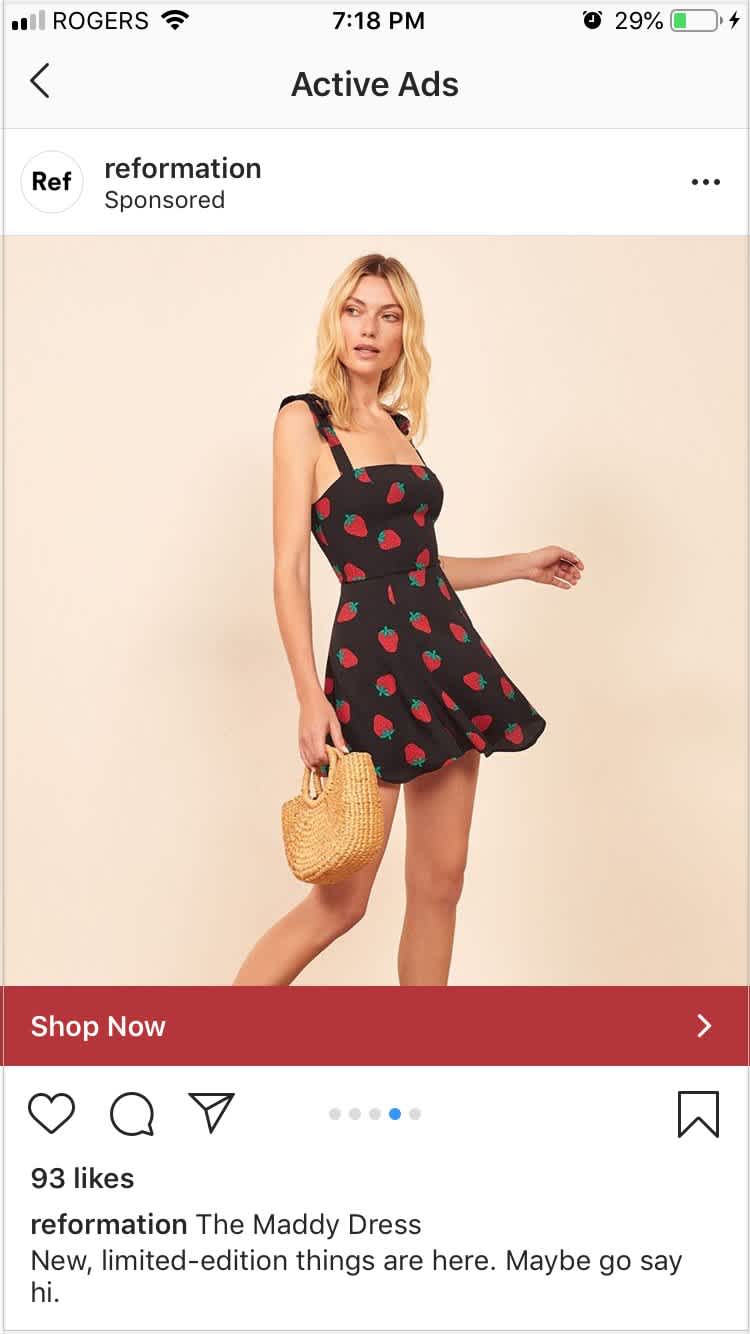
File type: JPG or PNG for photos, MP4 or MOV for videos
Size: a maximum of 30MB for photos and 4GB for videos
Length: a maximum of 60 seconds for videos
Number of cards: a minimum of 2 cards and a maximum of 10
Orientation: square
Resolution: Instagram recommends a resolution of 1080px by 1080px
Aspect ratio: 1:1
Caption text: a maximum of 2,200 characters but 125 is recommended (two rows of text will appear)
Headline: one row of text will appear
Objectives supported: all except Engagement, Messages, App Installs, and Video Views
When building Instagram carousel ads, it’s important to use imagery that’s cohesive and engaging.
You should also think about your user and goal. For example, if you’re trying to convert visitors, you should use photos and videos that capture the unique benefits of your product or service.
Some businesses also see great results by basing their carousel ads off user-generated content (UGC). If you’re promoting a product in your Instagram ads, try showcasing it in real-life situations that your audience can relate to.
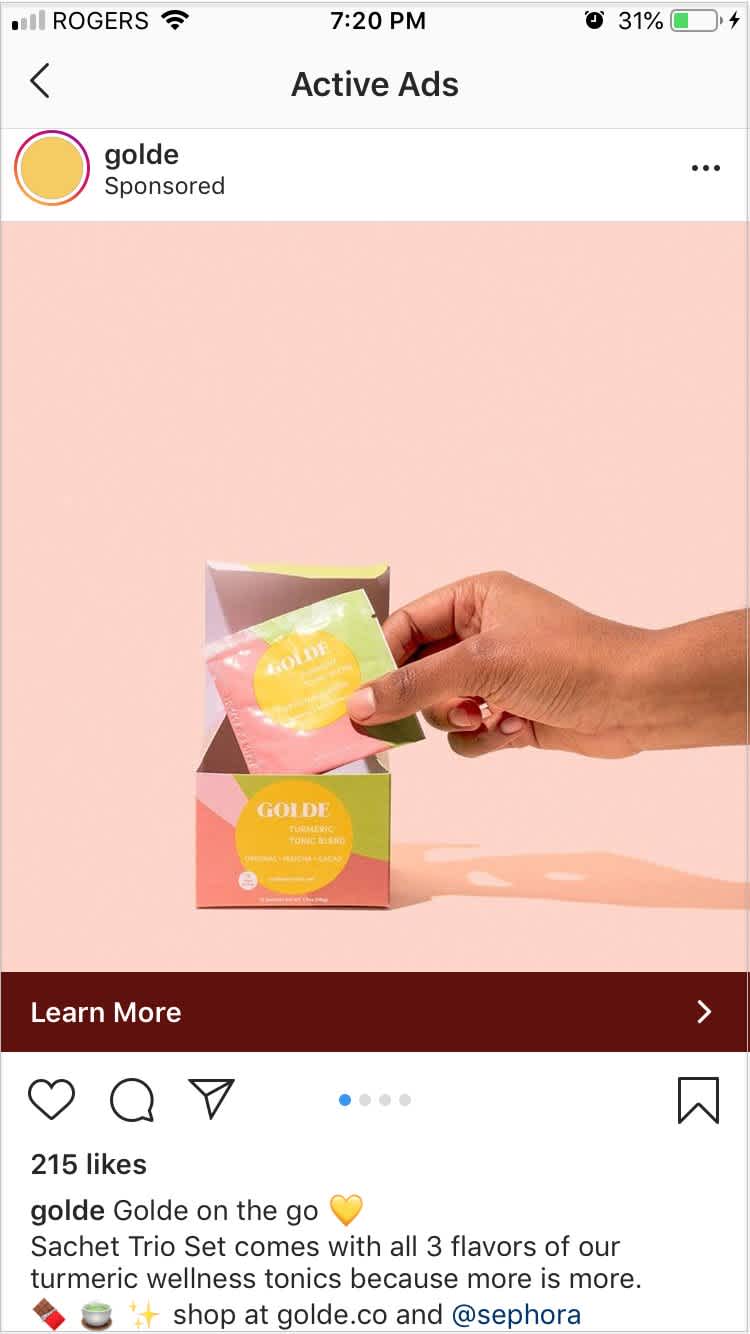
#5: Instagram Collection Ads
Instagram collection ads are all about making it easier for people to discover, browse, and purchase products and services from their mobile device!
Each collection ad features a primary video or image with three smaller accompanying images below in a grid-like layout.
When someone taps on collection ad, it opens up a fullscreen “Instant Experience” where they can interact with products or branded content.
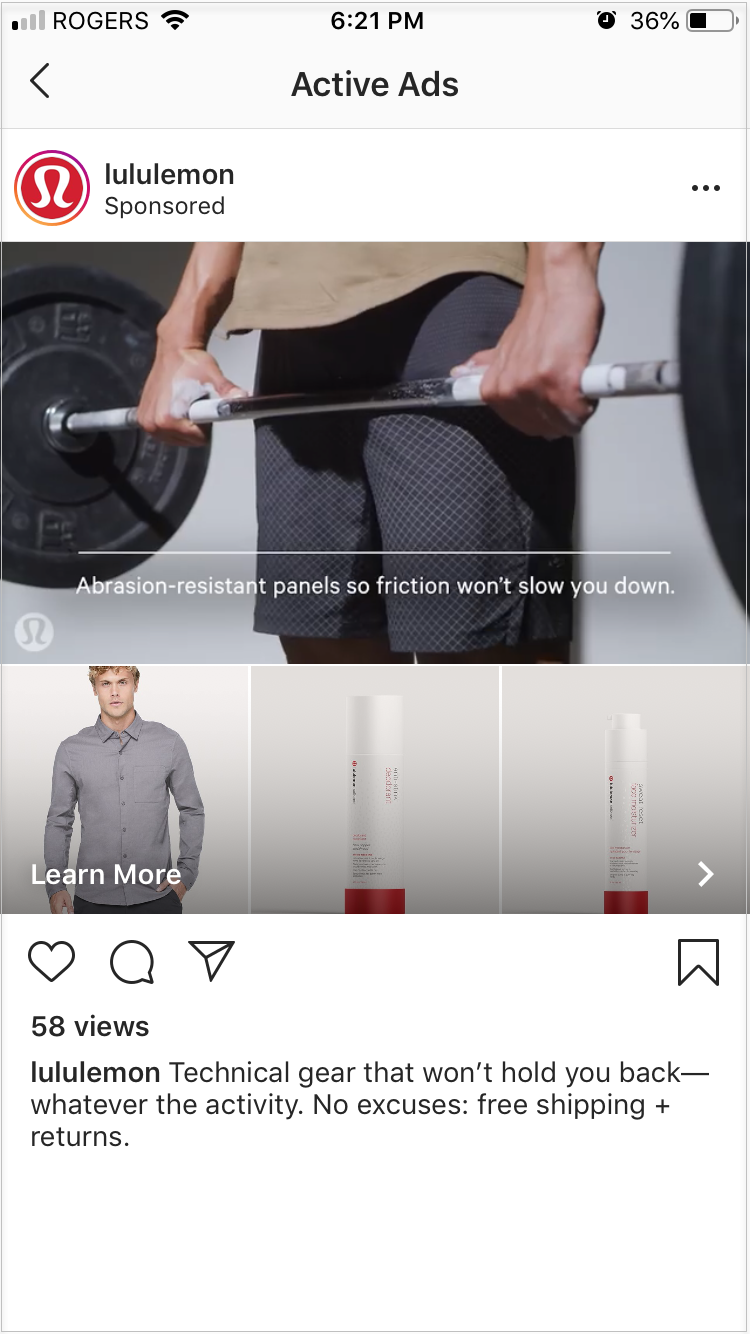
File type: JPG or PNG for photos, MP4 or MOV for videos
Size: a maximum of 30MB for photos and 4GB for videos
Length: a maximum of 60 seconds for videos
Orientation: square and landscape
Resolution: Instagram recommends uploading the highest resolution available that meets aspect ratio requirements
Aspect ratio: 16:9 to 1:1
Objectives supported: Conversions, Traffic, Catalog Sales, and Store Traffic
What makes collection ads so effective is that they let people move from discovery to purchase in a really smooth and immersive way.
Customers who tap on your collection ad can browse your products and branded content (and even make a quick purchase!) all without leaving Instagram.
This is the perfect format if you’re looking to showcase multiple products at once or if you want to drive people to your website or app to make a purchase.
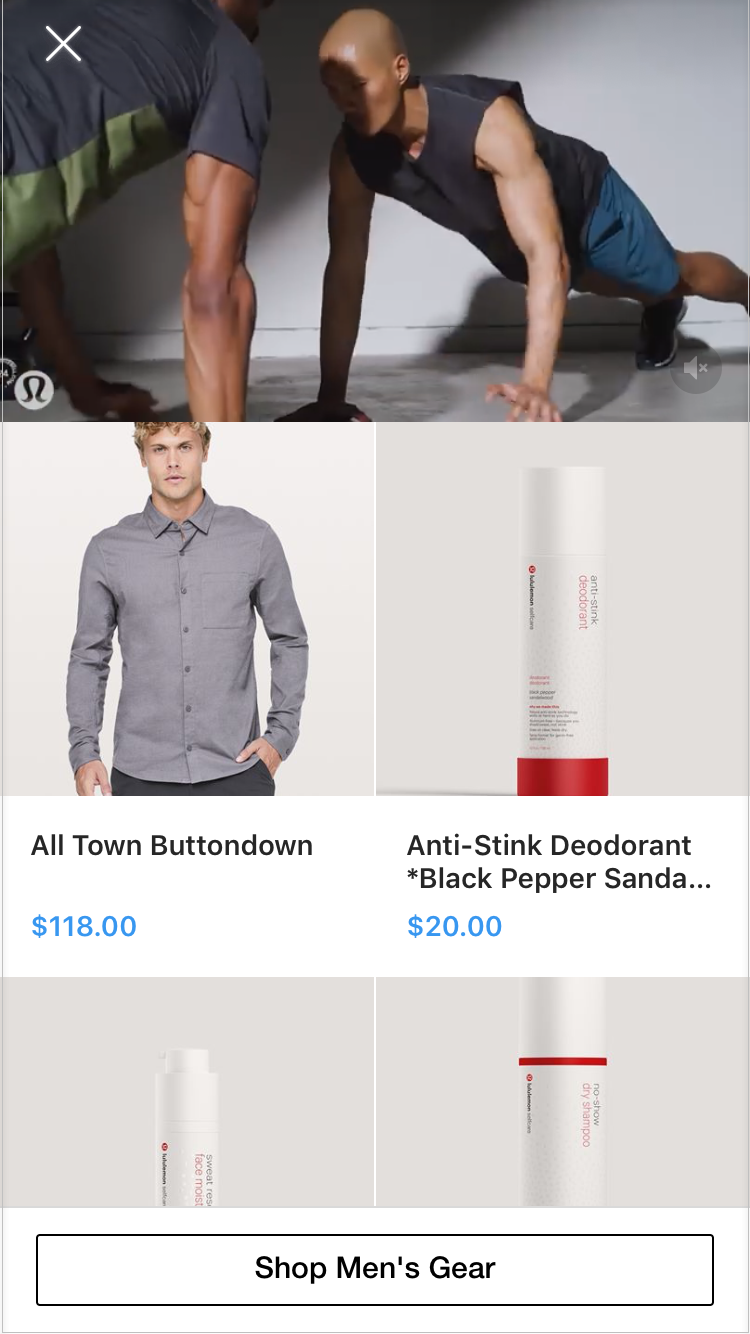
#6: Promoted Instagram Ads
Running your own Instagram ad campaign isn’t that difficult, but it can be intimidating to many small business owners and influencers who haven’t done it before.
The easiest way to run ads is by promoting posts and stories you’ve shared on Instagram.
Just select a post or story and tap Promote:

Instagram already pulls in a “similar audience” that you can share the post to, or you can easily create your own audience in the app by choosing an interest, age range, and the genders you want to promote to.
Once your promoted post is live, you can track how many people are seeing and interacting with it by tapping View Insights.
#7: Branded Content Ads
Thanks to Instagram’s new branded content ads feature, businesses can now promote influencer posts as ads on Instagram via Facebook Ads Manager (previously, businesses had no way of “advertising” or even boosting the sponsored posts their influencer partners created).

Basically, the new feature gives you everything you loved from traditional influencer marketing (i.e. the ability to promote your brand and products in a more authentic way) plus the added ability to optimize your campaigns towards a specific audience and objective.
Check out our step-by-step guide on how to run branded content ads on Instagram!
How to Measure the Success of Your Instagram Advertising Campaign
Unless you strike it lucky and have a successful campaign from day one, just launching your Instagram ad and hoping for the best is unlikely to produce great results.
Instead, you need to edit and optimize your Instagram advertising campaign as it runs!
When choosing which tool to track your Instagram advertising campaign, you’ll want to consider both your company size and the number of ads you plan to run. There’s three to choose from to suit your needs:
Power Editor: If you’re managing a large number of campaigns, or you’re looking for really precise control over your campaigns, you might want to use the Power Editor.
Business Manager: If you’re part of a large team, then Facebook’s Business Manager is probably best.
Ads Manager: If you’re just starting out with Instagram advertising, Facebook’s traditional Ads Manager should suit your needs fine.
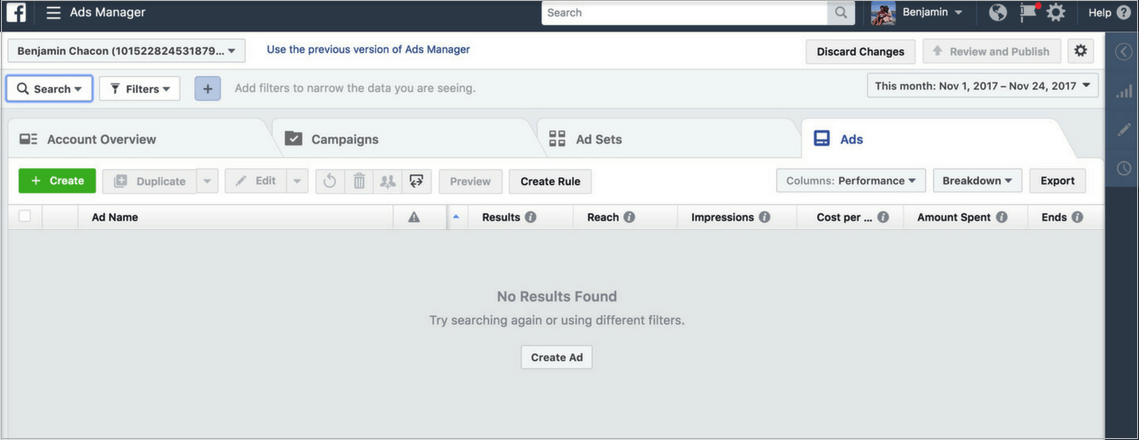
Performance metrics for your Instagram ad will be available in the Ads Manager shortly after you place your order. You’ll be able to look at metrics at the campaign, ad set, and ad levels.
You’ll also be able to schedule reports, save reports and customize columns in Ads Manager so that you only see the data you care about.
For more information, here’s a guide on how to use filters to customize the information you see in Ads Manager.
To see your Instagram ad metrics, go to the Ads Manager and click on the name of your Instagram ad campaign. From here you should see a section at the top right that includes Performance, Audience, and Placement data.
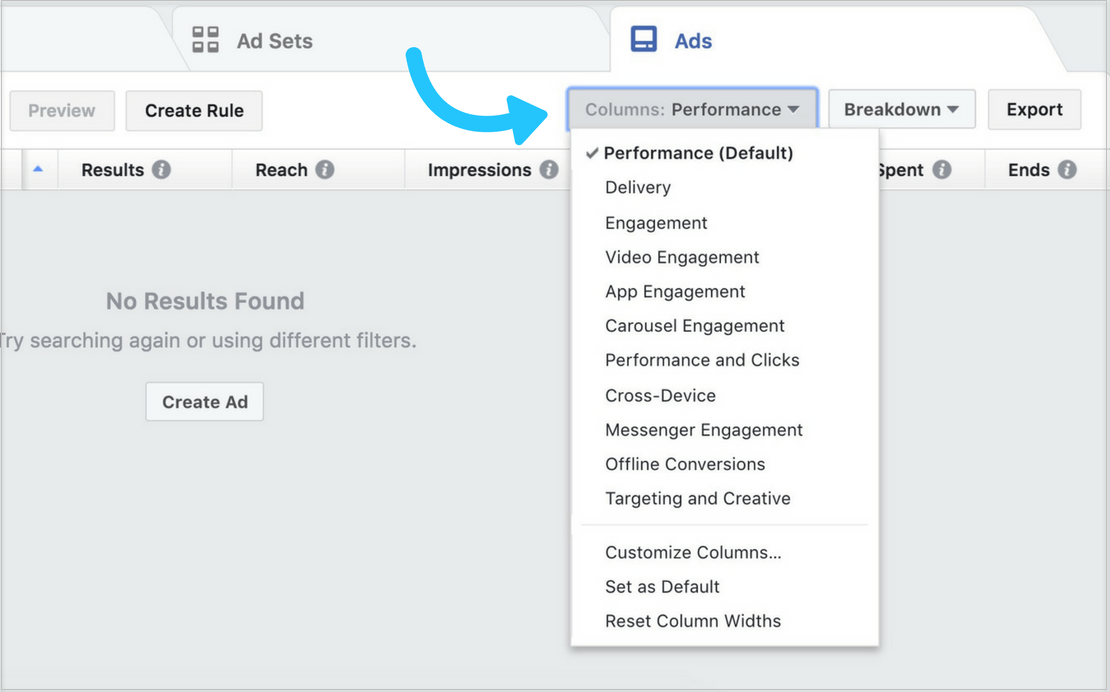
Depending on the objective you chose, you’ll see different results available. For example, if you created an engagement ad, you’ll see how many post engagements your Instagram ads have received, as well as total reach.
You can also view Amount Spent and Cost per Result to understand how your budget is being allocated.
As a general rule, if you have an ad that performs well, you should increase the ad spend every three days. On the other hand, if your ad doesn’t perform, don’t hesitate to shut it off.
And that’s it!
Getting started with Instagram advertising is easy, quick, and could make a real difference to your Instagram profile’s growth and business sales.
We recommend jumping right in and experimenting with different Instagram ads formats and styles and to which resonate with your audience the most!
Later is the #1 Instagram marketing platform for business. Sign up for free to schedule Instagram posts, organize UGC, plan your feed, and more:

